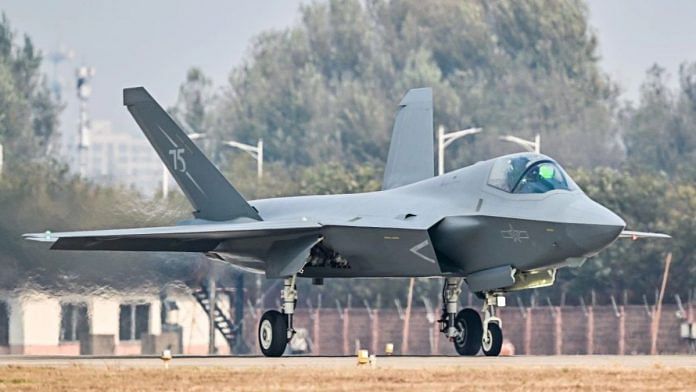New Delhi: Fifteen years after it was revealed that Chinese hackers had managed to hack and steal top American defence designs, the People’s Liberation Army Air Force (PLAAF) unveiled its new stealth fighter jet—the J-35A—earlier this week.
What catches everyone’s eye immediately is the striking similarities that the Chinese jet has with the American F-35 fighter.
The Chinese aircraft will be on display at the 15th China International Aviation and Aerospace Exhibition, which is scheduled to be held from 12 to 17 November in Zhuhai in South China’s Guangdong Province.
The PLA Air Force’s equipment department has announced that the J-35A will be part of the air show.
The J-35A is a multirole mid-size stealth combat plane. According to Chinese media, there are two versions of the jet—one designed for the air force and another for deployment on aircraft carriers.
While there has been no formal announcement from the PLAAF on the induction of the fighter jet into service, according to Chinese state-run tabloid Global Times, the PLAAF’s “announcement of the J-35A can be interpreted as confirmation of its entry into service”.
In China, the fighter jet is being seen as complementary to the J-20 stealth fighter jets, which are already operational with China, just like the United States’ F-22 and F-35.
Global Times quoted an expert as saying that the J-35A has multiple advantages in terms of “first detection, first strike”, besides “securing operational advantages”, and compared to previous generation of fighters operated by China.
Also Read: Rifles slung upside down, on ponies. Indian troops go on their 1st patrol in Depsang since 2020
J-35A vs F-35
J-35A is being compared to the F-35 Lightning II, developed by the US’ Lockheed Martin, due to the uncanny similarities in the design.
The F-35 family includes three variants: F-35A (conventional take-off and landing), F-35B (short take-off/vertical landing) and F-35C (carrier).
The fifth-generation multirole F-35 is capable of maintaining air dominance, and is equipped with Very Low Observable stealth, advanced sensors, information fusion and network connectivity. It is a single-engine, single-seat supersonic and long range fighter.
However, unlike the F-35, the J-35A is a twin-engine jet fighter.
Another difference is that while the F-35 was designed for the short take-off and vertical landing (STOVL) version, the Chinese fighter does not have that capability. In fact, the Chinese jet appears to be “sleeker and more slender than the F-35”.
The DSI inlets, canopy and basic configuration are similar, according to The War Zone.
Highlighting other key differences between the two jets, it reported that even though there are claims that China copied America’s design, or that it stole data to aid the aircraft’s development, it did not mean that the jet was ‘copied’. The portal added that China could not have ‘copied’ the F-35 because it was “one of the world’s most complex machines”.
Theft of F-35 design data
The US was faced with the theft of sensitive design data by hackers targeting programmes, like the F-35 Joint Strike Fighter. The theft through cyber intrusion was reported in 2009.
Defence acquisitions chief Frank Kendall told a Senate hearing in 2013 that he was “reasonably” confident that classified information of the F-35 was safe, but “not all confident” about the unclassified information. He also said that the “design and production edge had been forfeited to competing powers”.
His remarks had come after the Pentagon had said in its annual China report that Beijing was making use of cyber espionage to further its military modernisation programme.
It was also the first time that through the report, “cyber intrusions into US government computer systems appeared to be directly attributable to the Chinese government and military”.
A Los Angeles grand jury in 2014 had indicted a Chinese national named Su Bin, who was staying in Canada, for his involvement in a cyber-espionage scheme, allegedly perpetrated by People’s Liberation Army (PLA) hackers.
Bin was a businessman, who owned Lode Tech, specialising in aviation and aerospace products. Bin made close contacts in the global defence industry community, seeking insights into the “protected technology and eventually unfettered entry into company files”.
Between 2008 and 2014, Bin aided two PLA hackers in stealing more than 630,000 files related to the C-17 cargo aircraft as well as data related to the F-22 and F-35 fighter aircraft. He is also said to have helped the hackers in targeting specific companies, individuals and technologies, and also helping them translate the data obtained.
(Edited by Mannat Chugh)
Also Read: As IDF unveils robotic combat task force, Israeli maker says open to working with India






